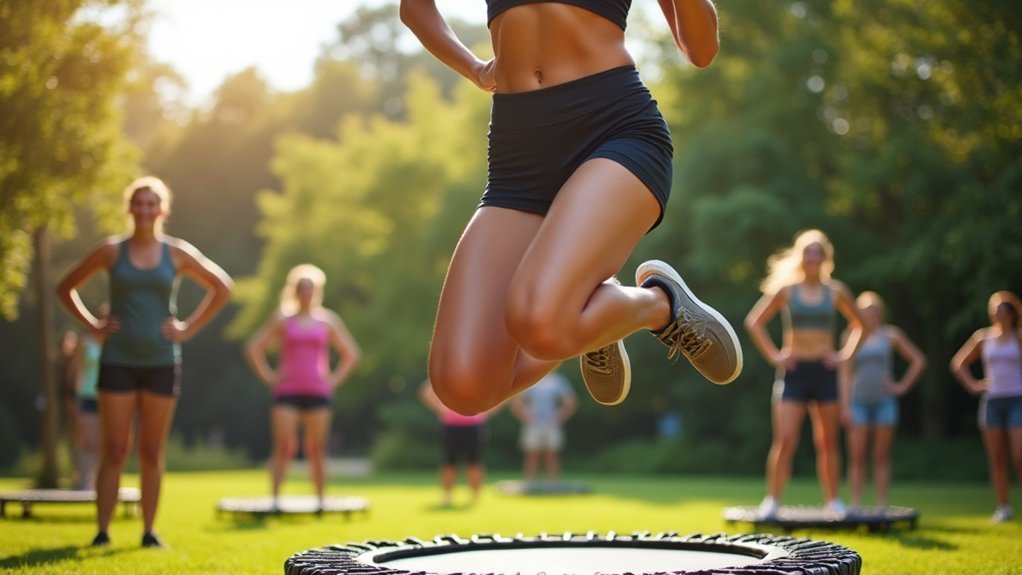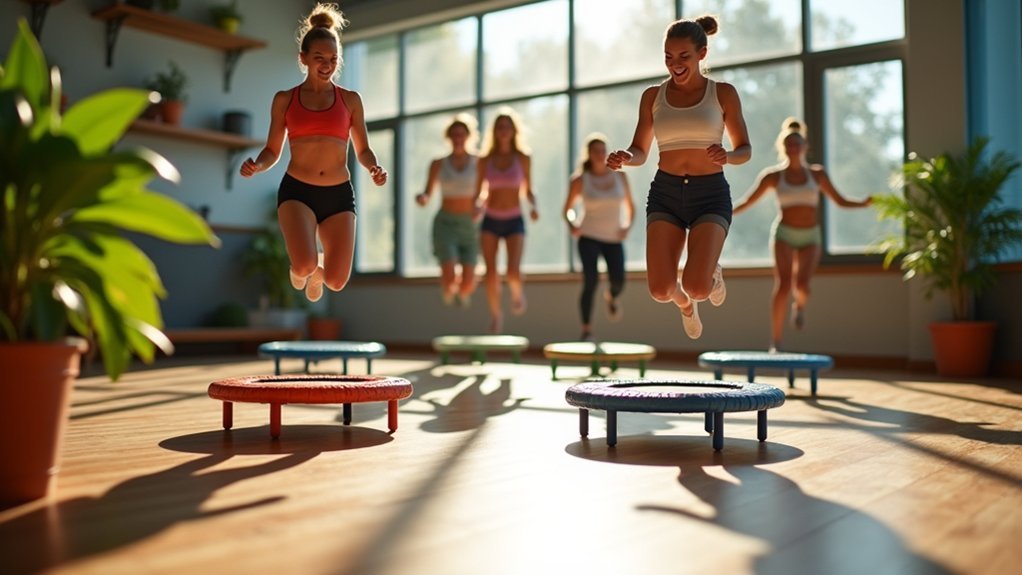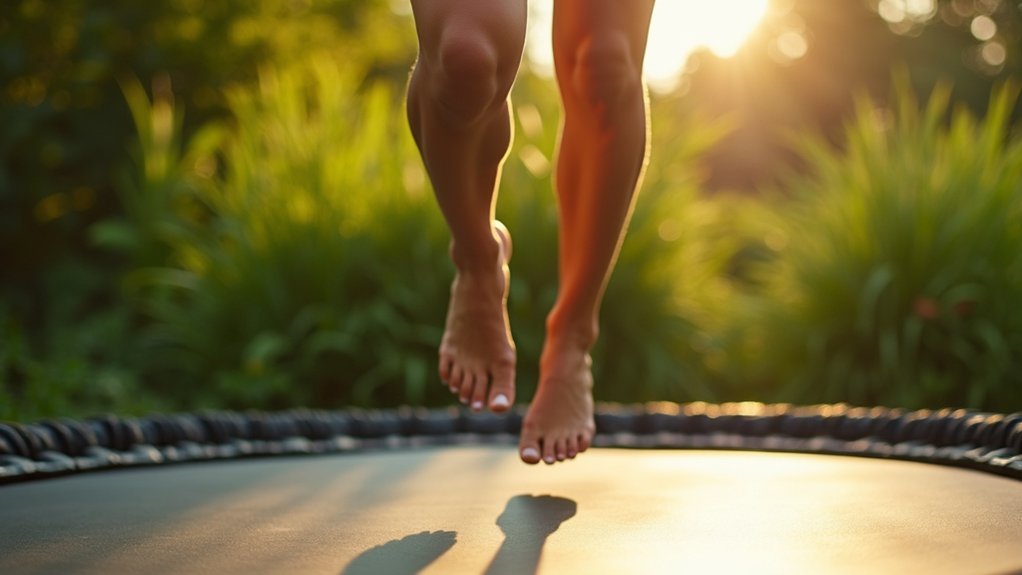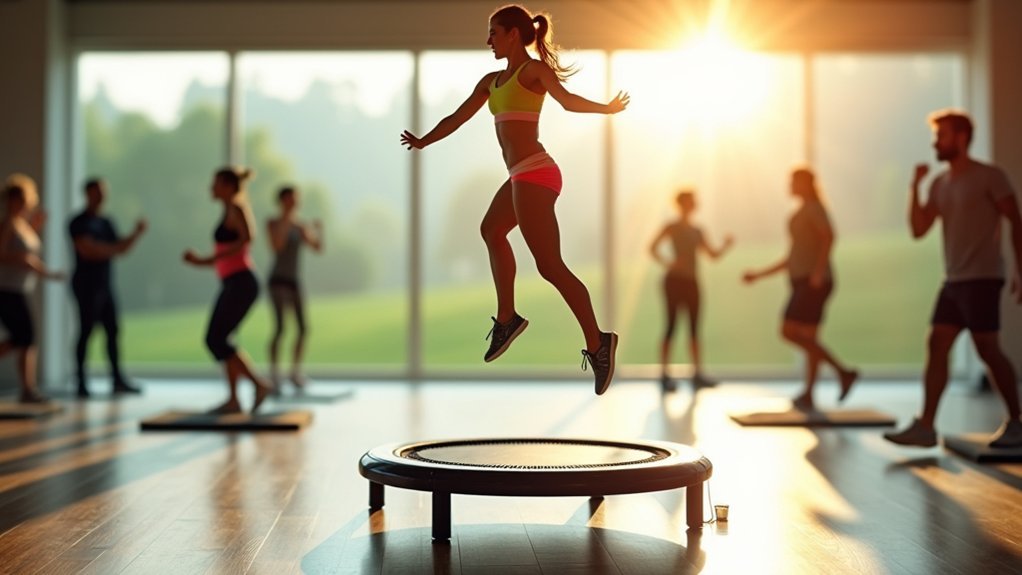Rebounding can help reduce cellulite by improving lymphatic drainage and circulation, but won’t eliminate it completely. Doctors note that while this low-impact exercise strengthens muscles and promotes detoxification in cellulite-prone areas, it doesn’t address structural causes like fibrous septae. You’ll see modest improvements with consistent practice (10-15 minutes daily for 8-12 weeks), especially when combined with proper nutrition and hydration. The full story reveals how to maximize your results through complementary approaches.
What Exactly Is Cellulite and Who Gets It?

Dimples may be cute on your face, but not so much on your thighs. That lumpy, orange peel-textured skin you’re seeing is cellulite—a harmless but often unwelcome condition that occurs when fat pushes through connective tissue beneath your skin.
If you’re dealing with cellulite, you’re far from alone. It affects 85-98% of women after puberty, particularly those of European descent, while appearing less frequently in East Asian women.
You’ll typically notice it on your thighs and buttocks, though it can appear on your abdomen and upper arms too.
Your genetics, hormones, age, and lifestyle all play roles in determining whether you’ll develop cellulite and how pronounced it might become.
Despite what many think, even thin, fit people can have cellulite.
The Science Behind Rebounding Exercise
With cellulite affecting most women, it’s natural to seek effective solutions. Rebounding—exercising on a mini-trampoline—offers compelling benefits that may help combat cellulite’s appearance.
When you bounce, you create changes in gravitational forces that enhance lymphatic circulation, a key factor in detoxification. This increased lymph flow helps remove waste and toxins that can contribute to cellulite formation. NASA research has confirmed rebounding’s unique benefits, describing it as “gravitational force overloading.”
The exercise also improves circulation throughout your body, increasing oxygen and nutrient delivery to tissues. Additionally, rebounding strengthens muscles and increases bone density, which can help tone the areas where cellulite typically appears. Unlike traditional high-impact exercises, rebounding provides a low-impact workout that reduces stress on joints while still delivering impressive results.
Rebounding supercharges circulation, nourishing tissues while building stronger muscles and bones—precisely what cellulite-prone areas need most.
The repetitive G-force impact during rebounding creates physiological adaptations that may reduce the dimpled appearance of affected skin.
How Lymphatic Circulation Impacts Skin Appearance

Your lymphatic system functions as your body’s natural detox mechanism, playing a critical role in how your skin appears and how cellulite develops. When this system flows efficiently, it removes toxins and excess fluid that can contribute to skin puffiness and the visibility of cellulite.
Improved lymphatic circulation delivers multiple skin benefits: reduced swelling, enhanced nutrient delivery, and better toxin removal. These processes can temporarily sculpt facial contours and create a smoother appearance in areas prone to cellulite.
Specialized drainage techniques—whether through massage, manual manipulations, or device-assisted methods—help redirect lymph flow through congested areas, potentially reducing water retention that makes cellulite more noticeable.
Beyond just addressing surface concerns, a well-functioning lymphatic system supports overall skin elasticity and metabolic health, which can indirectly improve both texture and tone.
Medical Perspectives on Cellulite Formation
Despite its common occurrence, cellulite remains scientifically complex, with medical research identifying multiple converging factors in its formation.
Your hormones play a significant role, particularly estrogen and progesterone. When these become imbalanced, they can affect fat metabolism and distribution.
Women’s unique fibrous connective tissue structure is equally important – unlike men’s crisscross patterns, women have parallel fibrous bands that create the characteristic dimpling when fat pushes against them.
Emerging research suggests deeper physiological aspects might contribute to cellulite development, including endothelial dysfunction, inflammation, and oxidative stress.
These factors may impair blood flow and cellular health in affected areas.
Treatment research reveals why traditional approaches often disappoint – they typically target symptoms rather than addressing structural causes like fibrous septae, which clinical evidence suggests might be more effective.
Rebounding’s Effect on Body Composition

Rebounding exercises offer promising pathways to address cellulite through meaningful changes in body composition. When you regularly bounce on a mini-trampoline, you’re engaging in a total-body workout that improves your muscle-to-fat ratio while enhancing metabolic function. Research has shown rebounding burns calories faster than traditional exercises like walking or jogging, making it highly effective for changing body composition.
| Body Composition Factor | Rebounding Impact |
|---|---|
| Muscle Tone | Strengthens multiple muscle groups simultaneously with low-impact stress |
| Fat Distribution | Increases metabolism, potentially reducing fat accumulation in cellulite-prone areas |
| Circulatory Health | Enhances blood flow and lymphatic drainage, addressing a key factor in cellulite formation |
While studies haven’t shown dramatic changes in overall body fat percentage from rebounding alone, the combined benefits of improved circulation, muscle tone, and metabolic activity create favorable conditions for reducing the appearance of cellulite over time.
Clinical Evidence: Does Rebounding Reduce Cellulite?
When examining the clinical evidence surrounding rebounding and cellulite reduction, a complex picture emerges. While studies show rebounding reduced lymphedema swelling by 56.6%, direct research on cellulite specifically remains limited.
The science suggests rebounding improves circulation and lymphatic drainage—both potentially beneficial for addressing fluid retention aspects of cellulite. Rebounding stimulates the lymphatic system by opening and closing valves, which helps reduce swelling and fluid retention associated with cellulite appearance.
- No randomized controlled trials directly measure cellulite reduction from rebounding alone
- Improved venous return and microcirculation may reduce subcutaneous fluid pooling
- Effects vary markedly based on your BMI and genetic factors
- Most promising results come from consistent rebounding combined with dietary changes
Medical professionals view rebounding as physiologically sound for lymphatic health, but typically recommend it as part of a thorough approach rather than a standalone cellulite solution.
Comparing Rebounding to Traditional Anti-Cellulite Treatments
To fully understand rebounding’s place in cellulite reduction, comparing it with traditional treatments reveals significant differences in approach, cost, and effectiveness. While creams offer temporary surface-level improvements, rebounding addresses root causes by enhancing circulation and lymphatic drainage. The up-and-down movements of rebounding significantly enhance the body’s ability to remove toxins that contribute to cellulite formation.
| Treatment | Cost | Effectiveness |
|---|---|---|
| Rebounding | $50-300 one-time | Cumulative results in 8-12 weeks |
| Topical Creams | $20-120/month | Temporary surface effects |
| Laser/RF Therapy | $2,000-4,500/session | Requires multiple sessions + maintenance |
You’ll find rebounding provides sustainable results without the risks associated with invasive procedures. Unlike liposuction or laser treatments that require significant recovery time, rebounding’s low-impact nature means you can incorporate it daily with minimal side effects while simultaneously improving overall fitness and addressing cellulite’s underlying causes.
The Role of Muscle Toning in Cellulite Reduction
Muscle toning plays an essential role in the battle against cellulite, addressing the condition from beneath the skin’s surface. When you build muscle through strength training, you’re actually creating firmer tissue that pushes against the skin, making dimpling less noticeable.
Your body’s improved circulation from regular exercise also supports collagen production and enhances lymphatic drainage, further reducing that orange-peel appearance. While many treatments exist, maintaining a healthy weight and developing stronger muscles may naturally improve skin texture since cellulite differs from fat and requires specialized approaches.
- Focus on compound exercises like squats and lunges that target large muscle groups near common cellulite zones
- Incorporate progressive overload to maximize muscle growth potential
- Combine strength training with HIIT for peak fat mobilization
- Be patient—consistent training over months is necessary for visible improvements
Remember that while genetics influence cellulite’s appearance, building muscle remains one of your most effective natural strategies for smoother skin.
Rebounding Frequency and Duration for Optimal Results
Establishing an effective rebounding routine involves finding the right balance of frequency and duration to maximize cellulite reduction benefits.
Begin with 10-15 minute daily sessions to allow your body to adjust to this unique exercise form. As your stamina improves, gradually extend your rebounding time while maintaining a moderate pace that doesn’t leave you gasping for breath.
For best results, you’ll need consistency—regular sessions yield more noticeable improvements in cellulite appearance than sporadic workouts.
Pair your rebounding routine with proper nutrition to enhance weight loss and skin-firming effects. Studies show you can burn calories 1.5 times faster while rebounding compared to traditional cardio exercises, potentially accelerating your cellulite-reduction results. Remember that sustainable progress comes from making rebounding a regular part of your lifestyle rather than treating it as a temporary fix.
Start small, stay consistent, and you’ll likely see improvements in both cellulite appearance and overall fitness.
Patient Success Stories and Before/After Analysis
You’ll find compelling evidence of rebounding’s effectiveness in the countless before-and-after photos shared by dedicated practitioners who’ve documented their cellulite reduction journey.
These visual transformations typically show smoother thighs and reduced dimpling after 8-12 weeks of consistent rebounding practice.
Many users report significant improvements in body composition and visible muscle tone improvements when following a consistent rebounding routine.
Long-term success stories consistently highlight that maintaining a regular rebounding routine prevents cellulite from returning, with many users reporting sustained results even years after beginning their practice.
Real-Life Transformation Evidence
While clinical studies on rebounding and cellulite remain limited, compelling real-life testimonials provide valuable insight into its potential benefits.
Many users report visible improvements in cellulite appearance after consistent rebounding routines, often attributing this to enhanced lymphatic circulation and muscle toning.
- You’ll find numerous success stories highlighting firmer skin and reduced cellulite dimpling within 2-3 months of regular practice.
- Before/after comparisons typically show improvements in thigh and buttock areas, where cellulite is most common.
- Many participants note additional benefits like improved posture and energy levels alongside cellulite reduction.
- Weight management success appears to complement cellulite improvements, with users reporting overall body composition changes.
These real-world transformations, while anecdotal, suggest rebounding’s potential effectiveness when practiced consistently as part of a thorough approach to cellulite management.
Visual Progress Documentation
Visual progress documentation transforms anecdotal reports into measurable evidence that can help assess rebounding’s impact on cellulite. When you track your journey, you’re not just relying on feelings—you’re gathering concrete data about your body’s changes.
| Measurement Method | What It Reveals |
|---|---|
| Standardized Photos | Visible skin texture changes, 26% cellulite reduction |
| Body Composition | Fat percentage shifts affecting dimpling appearance |
| Circumference Measurements | Waist reduction and overall contour improvements |
| Lymphatic Function | Reduced swelling and improved circulation markers |
| Self-Reported Changes | Clothing fit differences and skin tightening effects |
These documentation methods help overcome the evidence limitations that often plague cellulite studies. While small sample sizes and lack of standardized grading scales exist, your personal before/after documentation can still provide meaningful insights into your progress.
Long-Term Maintenance Results
Achieving initial results with rebounding is only half the battle when fighting cellulite; maintaining those improvements requires consistent effort and strategic approach.
Long-term success stories show that patients who document their progress tend to stay motivated and recognize subtle changes that might otherwise go unnoticed.
Your maintenance routine should incorporate these proven strategies:
- Mix up your rebounding routines every 2-3 weeks to prevent plateaus and keep challenging your body
- Combine rebounding with other activities like strength training to enhance muscle tone
- Maintain a consistent schedule of 3-4 sessions weekly, even if they’re shorter (10-15 minutes)
- Focus on hydration and anti-inflammatory foods to support the physiological changes happening beneath your skin
The potential decrease in cellulite appearance comes primarily through enhanced circulation that consistently improves with long-term rebounding practice.
Complementary Approaches to Enhance Rebounding Benefits
While rebounding offers significant cellulite reduction benefits, your diet and hydration habits can dramatically amplify these results.
Drinking adequate water and consuming whole, anti-inflammatory foods creates internal conditions that support lymphatic drainage and fat metabolism during your rebounding sessions.
Additionally, incorporating dry brushing before you rebound can help stimulate blood flow to affected areas, loosen trapped toxins, and enhance the circulation benefits of your trampoline exercises. Regular rebounding provides low-impact cardiovascular exercise that engages multiple muscle groups while promoting better blood circulation to areas affected by cellulite.
Diet and Hydration
Although rebounding provides significant benefits for cellulite reduction, your dietary choices and hydration levels can dramatically amplify these results.
Focus on consuming proteins that support collagen production while incorporating omega-3 fatty acids to improve skin elasticity and reduce inflammation.
Staying properly hydrated is equally important—aim for 8-10 glasses of water daily to flush toxins and plump skin, creating a smoother appearance.
- Include collagen-supporting foods like lean proteins and vitamin C-rich fruits
- Reduce sugar and starch intake to minimize water retention
- Consume polyphenol-rich foods (berries, green tea) to fight inflammation
- Prioritize omega-3 sources such as flaxseed and fatty fish for skin health
This integrated approach combines the circulation-boosting effects of rebounding with the internal nourishment needed for ideal skin structure and appearance.
Dry Brushing Benefits
Dry brushing serves as a powerful complement to your rebounding routine, targeting cellulite through multiple physiological pathways. This practice vigorously exfoliates dead skin cells while simultaneously stimulating blood flow to create smoother, more radiant skin.
When you brush toward lymph nodes using firm, sweeping motions, you’re supporting your body’s natural detoxification system, helping to reduce fluid retention that can exacerbate cellulite’s appearance. The mechanical action temporarily plumps skin and redistributes fat deposits for visibly improved texture.
| Benefit | Mechanism | Best Practice |
|---|---|---|
| Exfoliation | Removes dead cells | Use firm pressure |
| Circulation | Increases blood flow | Brush toward heart |
| Lymphatic support | Moves stagnant fluid | Target lymph nodes |
| Reduced puffiness | Drains excess fluid | Consistent daily use |
| Enhanced absorption | Preps skin for products | Apply treatments after |
Limitations of Rebounding for Cellulite Management
Despite its growing popularity as a fitness trend, rebounding presents significant limitations when it comes to cellulite reduction.
While it may improve lymphatic flow, it doesn’t address the fibrous septa causing dimpling or alter genetic factors that contribute to cellulite formation.
Rebounding stimulates lymph flow but can’t break down cellular fat structure or change your genetic predisposition to cellulite.
You’ll need to commit to months of consistent practice with 4-5 weekly sessions to see any noticeable results, which are often temporary without maintenance.
- Not recommended if you have joint problems, circulation disorders, or are recovering from surgery
- Works best when combined with specialized treatments and dietary improvements
- Results vary dramatically based on your age, BMI, and skin elasticity
- Lacks standardized protocols and clinical evidence specifically for cellulite reduction
Dermatologists’ Recommendations for Realistic Expectations
Dermatologists caution you’ll see only modest cellulite improvement from rebounding alone, as it doesn’t directly address the structural causes like fibrous bands or collagen degradation.
Research-backed treatments such as subcision, laser therapies, and topical retinoids consistently outperform exercise-only approaches for reducing the appearance of dimpled skin.
You’ll likely achieve better results by incorporating rebounding as part of a thorough strategy that includes clinically-proven interventions, consistent strength training, and proper skin care maintenance.
Setting Proper Expectations
When considering treatments for cellulite, establishing realistic expectations is essential to guarantee satisfaction with your results. Understand that most approaches require significant time commitment—topical treatments need 6+ months of consistent use, while even advanced procedures like Cellfina or Resonic require weeks to months for ideal results.
For the most effective approach to cellulite management:
- Prioritize mechanical treatments (Cellfina, Resonic) as your foundation, which boast 95% satisfaction rates.
- Layer treatments strategically—follow mechanical procedures with biostimulators for enhanced collagen production.
- Commit to daily maintenance with retinoid products while protecting skin from sun exposure.
- Remember no current solution offers permanent elimination—annual touch-ups and consistent lifestyle habits are necessary for sustained improvement.
While rebounding may complement these approaches, it shouldn’t replace evidence-based treatments that directly address the structural causes of cellulite.
Medical Science vs. Claims
While many manufacturers claim that rebounding can eliminate cellulite, dermatologists emphasize the importance of distinguishing between marketing hype and scientific evidence.
“There’s a notable discrepancy between what’s advertised and what’s proven,” explains Dr. Sarah Chen, dermatologist. “While one study suggests a 26% cellulite reduction from rebounding, it lacks methodological transparency.”
The reality is that no FDA-approved non-invasive treatments exist for cellulite. For moderate to severe cases, dermatologists recommend in-office procedures like acoustic subcision, which shows documented improvement in 70% of patients lasting beyond one year.
Rebounding may temporarily reduce fluid retention and improve lymphatic drainage, but it’s best viewed as a complementary approach rather than a standalone solution.
For lasting results, experts recommend combining multiple modalities while maintaining realistic expectations about gradual improvement.
Complementary Treatment Approach
For those seeking effective cellulite solutions, a multi-faceted treatment approach offers more promising results than rebounding alone.
Dermatologists recommend combining several strategies for noticeable improvement, with realistic expectations about outcomes.
- Clinically-proven options like Cellfina provide semi-permanent results by targeting the fibrous bands beneath the skin.
- Topical treatments containing retinol can boost collagen production and improve skin thickness when used consistently.
- Strength training builds muscle, enhances skin tone, and improves metabolism – all contributing to reduced cellulite visibility.
- Lifestyle modifications including proper nutrition and hydration work synergistically with professional treatments.
Remember that most treatments offer temporary results requiring ongoing maintenance.
The most successful approach typically combines professional procedures, at-home care, and consistent healthy habits rather than relying on any single solution.
Creating an Effective Rebounding Routine for Smoother Skin
To create an effective rebounding routine that targets cellulite, you’ll need to combine consistency with strategic movements. Start with just 10 minutes daily, gradually increasing intensity as your body adapts.
Focus on movements that target cellulite-prone areas like thighs and hips. Basic bouncing activates your lymphatic system, while the Jamba Run increases circulation and heat. Add leg lifts for thigh toning and jogging in place for cardiovascular benefits.
For maximum results, combine rebounding with other exercises like swimming or walking. Many users report visible improvements in skin texture within two to three weeks of consistent practice.
The key is maintaining your routine—rebounding works by improving lymphatic flow, reducing fluid retention, and enhancing blood circulation to the skin, all of which contribute to smoother-looking skin over time. Try incorporating the “spoiled child” exercise which mimics the benefits of a vibrating plate for enhanced cellulite reduction.
Frequently Asked Questions
Can Pregnant Women Safely Use Rebounding for Cellulite Reduction?
While you can rebound during pregnancy with medical clearance, it’s not reliable for cellulite reduction. Focus on gentle bouncing with stability bars, prioritize safety over cosmetic goals, and stop if you feel discomfort.
Do Different Trampoline Types Produce Varying Results for Cellulite?
Yes, trampoline types do affect cellulite reduction results. Bungee cord models offer smoother jumps for comfort during longer workouts, while higher-quality rebounders with proper tension provide more effective lymphatic stimulation and muscle toning.
How Does Age Affect Rebounding’s Effectiveness on Cellulite?
As you age, rebounding’s cellulite benefits diminish due to decreased collagen production, slower metabolism, and reduced lymphatic function. You’ll need longer, more consistent sessions and may want to combine with collagen-boosting nutrition for noticeable results.
Is Rebounding Effective for Cellulite in Men?
Yes, rebounding can help men with cellulite by improving lymphatic flow and muscle tone. You’ll see better results when you’re consistent with your bouncing routine and combine it with healthy eating habits.
Can Rebounding Worsen Existing Varicose Veins While Treating Cellulite?
Rebounding can worsen varicose veins if you bounce too vigorously. You’ll need to wear compression garments, maintain proper form, and keep sessions short. Start with gentle bounces to avoid stressing already weakened veins.
In Summary
While rebounding won’t magically erase cellulite overnight, you’ll likely see gradual improvements through its lymphatic benefits and fat-burning effects. Combine it with proper hydration, nutrition, and targeted skincare for best results. Don’t expect miracles—even doctors agree that consistency matters most. If smoother skin is your goal, a regular rebounding practice can be a valuable part of your overall approach.





Leave a Reply